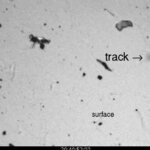Space
Scientists writing in the Monthly Notices of the Royal Astronomical Society say they have found evidence of a catastrophic event they believe was responsible for halting the birth of stars in SMM J1237+6203, a galaxy in the early Universe.
The researchers observed the massive galaxy as it would have appeared just three billion years after the Big Bang when the Universe was a quarter of its present age.
According to their findings, the galaxy exploded in a series of blasts trillions of times more powerful than any caused by an atomic bomb. The blasts happened every second for millions of years…
A reader was aghast-- outraged, I say-- at my suggestion that this precious music satellite, Project Calliope, might launch a few months late.
Now, the rocket people at InterOrbital Systems are rock-solid and haven't had any reason to announce a delay. Their testing is on track. Certainly (as this blog shows) my satellite construction in proceeding in a timely fashion. So why do I think we won't launch until 2011?
The answer is just about everything launches late. Late is the new early. The launch industry is predicated on being absolutely perfect with engineering details, and wildly…
A team of astronomers writing in Astrophysical Journal Letters has shown that the two stars in the binary HM Cancri revolve around each other in a mere 5.4 minutes, making HM Cancri the binary star with by far the shortest known orbital period. It is also the smallest known binary; The system is no larger than 8 times the diameter of the Earth.
The team was able to prove the short binary period of the system by detecting the velocity variations in the spectral lines in the light of HM Cancri. These velocity variations are induced by the Doppler effect, caused by the orbital motion of the two…

ESA’s Herschel Space Observatory has revealed the chemical fingerprints of potential life-enabling organic molecules in the Orion Nebula, a nearby stellar nursery in our Milky Way galaxy. This detailed spectrum, obtained with the Heterodyne Instrument for the Far Infrared (HIFI) - one of Herschel's three innovative instruments - demonstrates the gold mine of information that Herschel-HIFI will provide on how organic molecules form in space. Several German Institutes contributed essential parts to the HIFI instrument: the Universität zu Köln and two Max Planck Institutes: Radioastronmie (Bonn…

The recent earthquake in Chile was so big, it altered the earths rotation. So if you notice the days getting shorter, blame the quake. According to NASA scientist Richard Gross, the earth has been knocked about 3 inches off of its axis! This resulted in a 1.26 microsecond shortening of the day.
Actually, this isn’t so unusual. Any time a major geological event moves the mass of the earth around a bit, it will alter the way the earth spins. The last time we saw a big jolt was in 2004’s Sumatra quake of 9.1 altered the axis of the planet by 2.76 inches. We…

Most people think that science is done behind closed doors with expensive equipment, fiddling around with complicated technology by scientists wearing cheap lab coats. The rest of us merely stand on the outside waiting for some interesting discoveries to be made. Well, although the caricature is partly true there are many experiments where the amount of data is so huge that the research teams have enlisted the help of citizen scientists.
Bruce Hudson, from Ontario in Canada, is just such a citizen scientist and he has discovered what scientists believe is the first piece of interstellar dust…

The Bud Light commercial about astronomers is astoundingly accurate. Details they get right include:
we like celebrating just about anything, good or bad
we drink beer in large groups
we sometimes make mistakes but, hey, that's science
playing with fire extinguishers is fun
science chicks are hot (seriously... brains, cuteness and ability to stay up late = win!)
In fact, in the whole 30 seconds, there's only two details they got wrong. The first is I can't think of any astronomers who actually drink Bud Light. Sorry. And the second, well, modesty forbids me from…

Cosmic oddities have set astronomers onto ‘the case of the missing neighboring galaxies’. Located half a billion light-years from Earth, ESO 306-17 is a large, bright elliptical galaxy in the southern sky known as a fossil group. Astronomers use that term to emphasize the isolated nature of these galaxies but are they really like fossils, the last remnants of a once-active community, or did ESO 306-17 gobble up its next-door neighbors?
Gravity brings galaxies together and bigger ones swallow smaller ones. There is evidence that our own Milky Way galaxy has snacked on…
Astronomers have discovered a star that may have been among the second generation of stars to form after the Big Bang.
Located in the dwarf galaxy Sculptor some 290,000 light-years away, S1020549 has a remarkably similar chemical make-up to the Milky Way's oldest stars. Its presence supports the theory that our galaxy underwent a "cannibal" phase, growing to its current size by swallowing dwarf galaxies and other galactic building blocks. The discovery of the new star is detailed in Nature.
Dwarf galaxies are small galaxies with just a few billion stars, compared to hundreds of billions in…

NASA creates dramatic artistic renderings of upcoming launches, in full color animation, often scaled for the IMAX screen. They're great eye candy, but they are also informative, and have genuine science at their core.
For example, the STEREO solar panel deployment is fascinating to watch, even as a simulation. It uses a highly accurate 3D model of the actual spacecraft, and attempts to balance physical realism with artistic license. Noteworthy is the robotic nature of the deployment and the oscillation of the solar panels as they deploy.
I will keep this proud tradition…